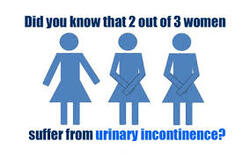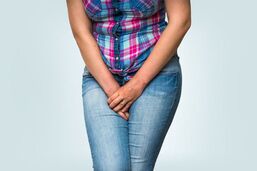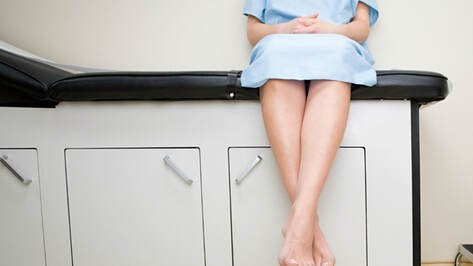“ I have some problems with a little urine leakage, but I have had two kids, so this is normal.”  These are common statements that are often heard from patients in our clinic. While the occurrence of urinary incontinence is common among seniors, it must not be regarded as a normal aging side effect. It is a problem that can be successfully addressed and treated! According to the National Association for Continence 25 million Americans have issues with incontinence. Only 1 in 12 people will seek medical advice about it; perhaps because it is an uncomfortable issue to talk about, or possibly because of the belief or acceptance that it is a normal part of growing older. The fact is urinary incontinence is costly: economically, psychologically and physically.
Causes of Incontinence The causes of incontinence can vary from an urinary tract infection to something more complex associated with a chronic medical condition.
Types Of Urinary Incontinence  Stress Urinary Incontinence This type of incontinence occurs secondary to weakness of the core muscles and fascial connections around the bladder. The pressure on the bladder causes leakage during coughing, sneezing, laughing, and during exercise. It can also occur when lifting or bending over. Urgency Incontinence This type of incontinence is associated with urgency and an overactive bladder (OAB). There is a strong, sudden urge to urinate. The bladder contracts and an involuntary loss of urine occurs. Overflow Incontinence This type of incontinence occurs due to an overflow of urine in the bladder. This can be due to a blockage at the urethra such as an enlarged prostate, poor sensation of the bladder, or the nerves to the bladder are affecting the ability of the bladder to empty completely. Functional Incontinence A person may have normal bladder control, however physically cannot make it to the restroom in time. Regardless of which type of incontinence a person may have, nonsurgical management, such as physical therapy, is the first line of treatment. Physical Therapy For Incontinence Bladder Retraining Bladder retraining involves different aspects depending on the issues/needs of the patient
Pelvic Floor Muscle and Core Training The coordination of the pelvic floor and abdominal muscles is very important to continence. It is not just about doing kegels, but coordinating the entire core and postural system.
The bottom line is that non-invasive treatment options in physical therapy are extremely beneficial and successful in addressing symptoms associated with urinary incontinence. In other words, there is NO reason that you should just expect urinary leakage to be a normal part of your life! Especially when you can address these symptoms often in as little as 3 weeks with targeted exercise and training!
For more information or to schedule an appointment to see a pelvic floor physical therapist, please click below.
0 Comments
Healthcare for moms is ripe for a revolution. Currently in the United States, postpartum checkups occur around 4-6 weeks after childbirth and only last about 10 minutes. You may have a brief pelvic examination, talk about future birth control plans, and likely get an “all clear” from your doctor, stating you can return to activity as usual. This means sex, exercise, and work. And that is your postpartum care. No more follow ups. No discussion of common pelvic floor conditions women experience. No discussion about steps to take if problems arise. Chances are you will not have your abdomen assessed for diastasis recti, a separation of your abdominal muscles that commonly occurs during pregnancy. You may feel and look like you are still pregnant and your diastasis will not be diagnosed. You may have pelvic floor problems like urinary leakage, painful sex, or pelvic organ prolapse and not know that diastasis recti and pelvic floor dysfunction often go hand in hand. You may not know that the crunches you are doing to get your abs back after the baby could be making this condition worse. And you may have no idea that pelvic physical therapy can help. Yup, you’re good. All clear. Chances are you will not have your pelvic floor muscles tested by your doctor to assess for weakness or spasm. You may go back to running and leak urine. You may do jumping jacks and feel heaviness in your vagina like something is falling out. You may start yoga, which you hear is great for postpartum recovery and have embarrassing vaginal farts. You may get on a spin bike or stair stepper and have excruciating tailbone pain. And you may have no idea that any of this may be due to weak or tense pelvic floor muscles and pelvic physical therapy can help. Yup, you’re good. All clear. Chances are you will not have a conversation with your doctor about returning to sex and the discomfort or pain many women experience after childbirth. Healing tissue from a vaginal tear or episiotomy may cause a pain with penetration during sex and maybe even cause some bleeding afterwards. Your vagina may be very dry, you can’t orgasm, or you may leak urine when you orgasm. And you have no idea that pelvic physical therapy can help, so you just bear through the pain or avoid sex altogether. Yup, you’re good. All clear. Chances are you won’t receive education on how to massage your C-section scar. You have bladder problems, groin pain, or constipation all stemming from your scar tissue restriction. You can’t wear jeans anymore, you avoid lying on your stomach, and you don’t like wearing your baby in a carrier because your scar hurts. And you have no idea that pelvic physical therapy can help, so you just deal with it. Yup, you’re good. All clear. Women’s bodies go through incredible physical, hormonal, and musculoskeletal changes during pregnancy and childbirth. As a pelvic health physical therapist, I have worked with women during pregnancy and the postpartum period for over a decade. I help educate them how to care for their pelvic floor muscles, inform that that any pain, leakage, or prolapse is not normal. I guide them on a safe return to exercise, sex, and activity to meet the increasing demands of their lives. Time and time again I hear, “I had no idea this type of physical therapy existed” or “why didn’t my doctor tell me about this sooner.” The postpartum care for women is in desperate need of improvement and the awareness of pelvic physical therapy needs to grow. Pelvic Physical Therapy should be standard care for every postpartum woman in the United States. I am baffled that medical professionals send sleep-deprived women home with bleeding vaginas, tender scars, sore breasts and a newborn baby to care for – and all they get are - Yup, you’re good. All clear. This was originally posted on The Vagina Whisperer by Sara Reardon Pelvic Floor Physical Therapy is covered by your insurance!
If you are postpartum (even if you had your last baby 50 years ago or more!!) click below to schedule your appointment today! |
AuthorEmily Craigen, owner of Crystal Lake Physical Therapy, is a Doctor of Physical Therapy and a local Crystal Lake resident who is excited to bring health and wellness to her community. Archives
August 2023
Categories |
- Home
- About Us
-
What We Treat
- Arthritis
- Balance and Gait Disorders
- Back Pain and Sciatica
- Chronic Pain
- Elbow, Wrist and Hand Pain
- Fibromyalgia
- Hip and Knee Pain
- Incontinence
- Motor Vehicle Accident Injuries
- Multiple Sclerosis
- Neck Pain
- Pelvic Pain
- Pre-Surgical Rehab
- Post Surgical Rehab
- Shoulder Pain
- Sports Injuries
- TMJ Dysfunction
- Vestibular Rehab
- Work Injuries
- Myofascial Release
- MPS/Dolphin Neuro Stim
- Become A Patient
- Contact Us
- Blog
- Workshops
- Patient Resources



 RSS Feed
RSS Feed